- HOME
- RESEARCH
- Research Clusters
- Microstructure Analysis and Grain Boundary Engineering
RESEARCH
Microstructure Analysis and Grain Boundary Engineering
Many of the materials around us are polycrystalline materials composed of many crystals or "grains". Grain boundaries are interfaces between two grains of different orientations, and their structures and properties depend on the crystal orientation relationship between the neighbouring grains. The properties of grain boundaries often control the physical properties of the entire polycrystalline material. One example of the importance of grain boundaries is the issue in solar cells of polycrystalline materials, a key technology in the search for greener and sustainable energy, grain boundaries are one of the main causes of losses causing decreases in the conversion efficiency of sunlight to electrical energy, but an important point is that not all grain boundaries contribute to this loss to the same extent. There are certain types at which the decrease in the conversion efficiency hardly occurs at all. This example shows that it is important to make the best use of the individual characteristics of grain boundaries to design and control materials properties. The research in our group takes as its basis grain boundary and interface science and engineering and the PMP triangle of 'Microstructure-Properties-Processing', with the aim of developing advanced materials with excellent function and performance.

Cluster members
-
 Sadahiro TSUREKAWA
Sadahiro TSUREKAWAProfessor
Faculty of Advanced Science and Technology, Kumamoto UniversityJapan -
 Dmitri Aleks MOLODOV
Dmitri Aleks MOLODOVProfessor
Institute of Physical Metallurgy and Metal Physics, RWTH, Aachen University
*IROAST Distinguished ProfessorGermany -
 Pavel LEJČEK
Pavel LEJČEKProfessor
Institute of Physics, Academy of Sciences of the Czech Republic
*IROAST Visiting ProfessorCzech Republic -
 Mitsuhiro MATSUDA
Mitsuhiro MATSUDAAssociate Professor
Faculty of Advanced Science and Technology, Kumamoto UniversityJapan -
 Thomas WAITZ
Thomas WAITZAssociate Professor
Faculty of Physics, University of Vienna
*IROAST Visiting ProfessorAustria -
 Christian RENTENBERGER
Christian RENTENBERGERAssociate Professor
Faculty of Physics, University of Vienna
*IROAST Visiting ProfessorAustria -
 Yoshitaka MATSUKAWA
Yoshitaka MATSUKAWAAssociate Professor
Faculty of Advanced Science and Technology, Kumamoto UniversityJapan
Achievement
Publications
- 2024
-
-
-
High temperature deformation and recrystallization behavior of magnesium bicrystals with 90° <101¯0> and 90° <112¯0> tilt grain boundaries
-
Journal of Magnesium and Alloys, 2024, 12, 2, 625-638
-
High temperature deformation and recrystallization behavior of magnesium bicrystals with 90° <101¯0> and 90° <112¯0> tilt grain boundaries
-
- On Melt Growth and Microstructure Characterization of Magnesium Bicrystals
-
Crystals, 2024, 14 (2), 130
-
- 2023
-
-
- Structural changes of TiPt high-temperature shape memory alloys induced by high pressure torsion
-
Journal of Alloys and Compounds, 935, Part 2, 2023, 168037
Publications
Grants
- Matsuda: Promotion of Joint International Research (International Collaborative Research) of KAKENHI, "Characteristic control based on quantitative evaluation of nano-defect and defect-induced strain field in functional materials", Grant Number 23KK0087 (from FY2023 to FY2027).
- Matsuda: Grant-in-Aid for Scientific Research (B), “Development of high temperature shape memory alloy based on the atomic shuffling mechanism in martensitic transformation”, Grant Number JP20H02427 (from FY2020 to FY2023).
- Tsurekawa: Grant-in-Aid for Scientific Research (B), “Grain boundary – dislocation interactions under chemical and physical reaction fields associated with grain boundary segregation”, Grant Number 20H001760 (from FY2022 to FY2025).
- Tsurekawa: The Iron and Steel Institute of Japan Research Promotion Grant, “Impact of grain boundary character and structure on hydrogen embrittlement of grain boundary in a-iron” (from FY2022 to FY2023).
- Tsurekawa: The Iron and Steel Institute of Japan (ISIJ) Research Project, "Approach of grain boundary engineering for achieving high- permance steels" (from FY2023 to FY2025).
Activities
Tsurekawa’s (ST) group
- Prof. D. A. Molodov's (DM) stay at Kumamoto University in May 2023
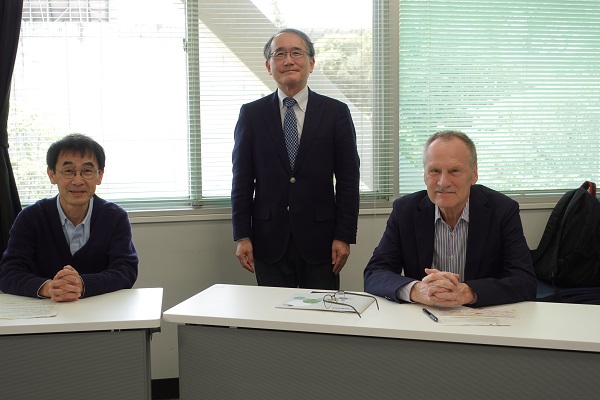

(At the meeting with Director of IROAST in May 2023)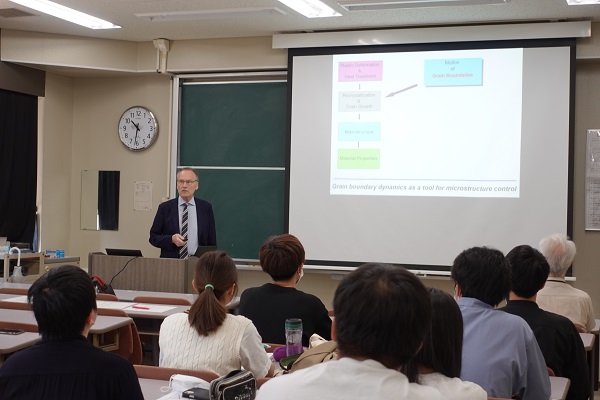
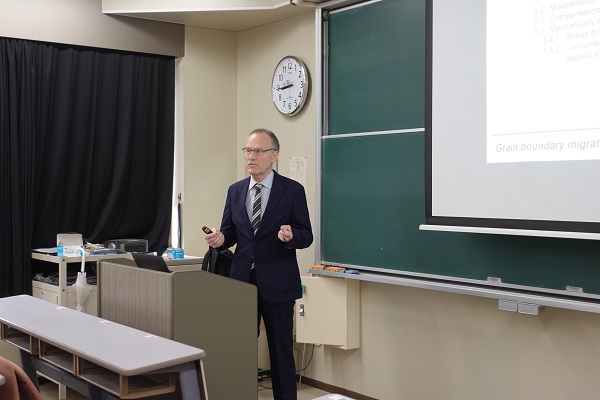
(Lectures on "Grain Boundary Migration" at the 94th and 95th IROAST Seminar)
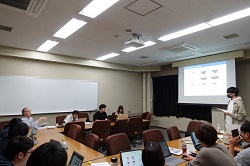
(At the Discussion meeting on research progress with students in Tsurekawa Lab) - Prof. D. A. Molodov's stay at KU in October 2023
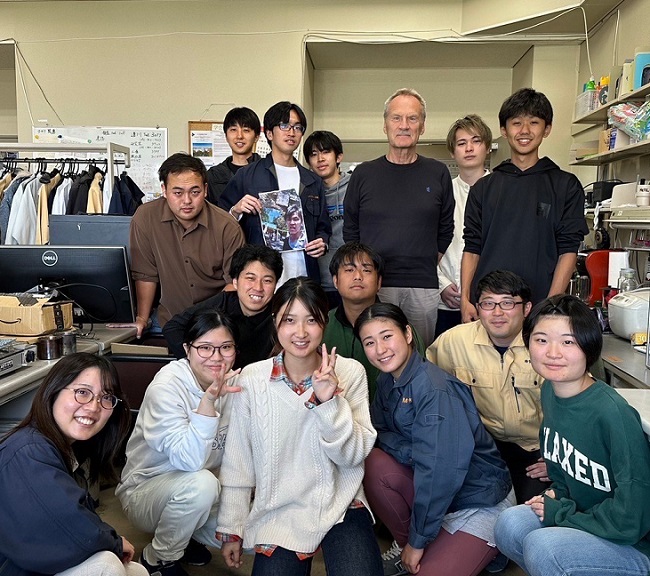
(With students in Tsurekawa Lab) - Prof. P. Lejček's stay at Kumamoto University in Feb. 2024
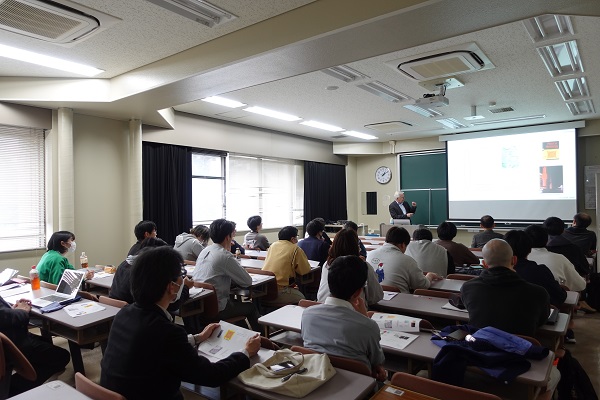
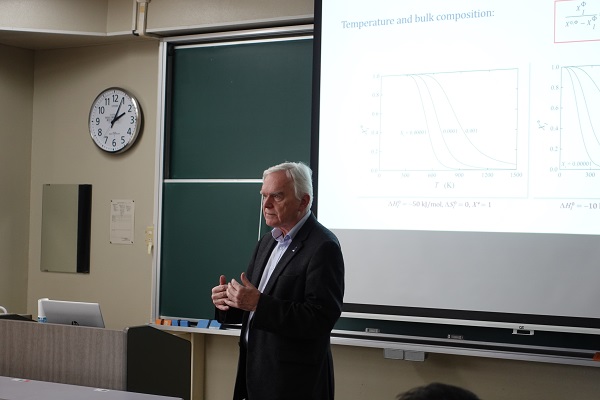
(Lecture on "Introduction to grain boundary segregation" at the 117th IROAST Seminar) - Stay of Profs. D. A. Molodov and P. Lejček at Kumamoto University in Nov. 2022
- The IROAST workshop entitled "Fundamentals of Grain Boundary Phenomena", where four invited speakers, including Prof. D. A. Molodov and P. Lejček
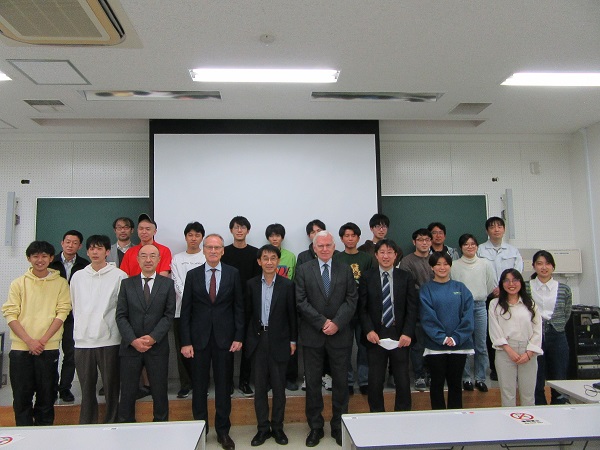
M. Matsuda’s (MM) group
- Discussion with Vienna's Group (Prof. T. Waitz and Prof. C. Rentenberger) by e-mail and web meeting at twice a month
- Stay at University of Vienna in Dec. 2022 to collaborate the research
- publication of the co-authored paper entitled as “Structural changes of TiPt high-temperature shape memory alloys induced by high pressure torsion” to Journal of Alloys and Compounds in 2023
- Cluster of Young Researchers
-
- Ferroelectric Photovoltaics
- Next-Generation Design of Building Structures-DfX
- Low-Dimensional Molecular Electronics and Spintronics
- Development of extrachromosomal DNA control system for reprogramming drug-resistant cancer
- Development of Microbially-Aided Carbon Sequestration Technology
- Digital Plant Cell Biology
- Deep Learning for Hydrology
- Study of First-Generation Objects in the Universe with Radio Telescopes
- Separation, Synthesis, and Detection by Means of Ionic Solutes Handling
- Advanced Biomedical Evaluation System
- Environmentally Promising Processes for Medical and Skincare Nanomaterials
- Environmental Diagnosis on Earth Surface Systems
- Novel Cancer Medical Technology Using Liquid Biopsy
- Cluster of World-leading Researchers
-
- Development of Nano and Supramolecular Materials
- Plant Cell and Developmental Biology
- Nano-Organics and Nano-Hybrids
- Nano-medicine and Drug Delivery System
- Nano-medicine and Theranostics
- Structure and Dynamics of Materials Using Quantum Beams and Data-Driven Sciences
- Quantification of Three Dimensional Vascular Network
- Advanced Structural Materials
- Plant Stem Cells and Regeneration
- Microstructure Analysis and Grain Boundary Engineering
- Nano-materials for Energy Applications and Environmental Protection
- Micro- and Nanomechanics of Materials Science & Biological Systems





